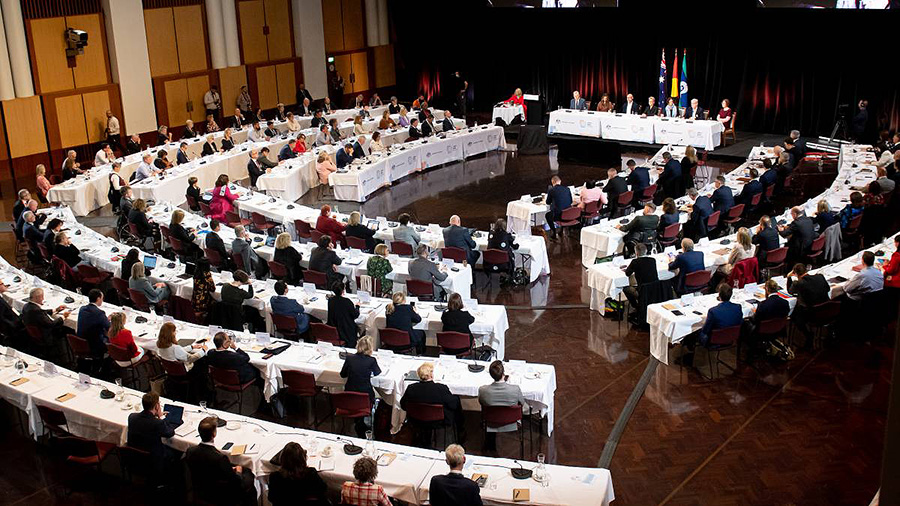Contributed by Joe Montero
The jobs summit was going to deliver a consensus that will chart a way forward towards a fairer Australia. At least that is what we were told. Those who knew better knew that the hype was mostly spin and photo opportunities. Now that it is over, little of substance came out of it.
Sure. It was an opportunity for various sectors to put their concerns on the table. Some did. But there was a sense that all the important decisions had been made before the parties came to the summit.

Photo by Elesa Kurtz: At the jobs summit in Canberra
Many a commentator has pointed out that the main purpose of the gathering was to generate goodwill between government, business, and unions. Maybe so. But the purpose for this goodwill is just as important. If not more so.
Judgement must be based on the outcomes, and here are the main ones.
- TAFE will get $1 billion for free course places for 465,000 students in 2023.
- Age pensioners will be able to work and earn an extra $4,000 per year without having their pension cut.
- Giving the private sector access to the $575 million National Housing Infrastructure Facility for social and affordable housing.
- Reintroducing pattern bargaining and amendment to the Fair Work Act to increase working arrangements flexibility.
- Improving access to jobs and training pathways for women, First Nations people, regional Australians, and linguistically diverse people, including 1,000 digital apprentices in the Australian public service, and other measures to reduce barriers to employment.
- Increasing permanent migration to Australia to 195,000 in 2023-32 to ese workforce shortages.
- Extend visas and relaxing work restrictions for international students.
Some of these give aways are positive, like increasing access to TAFE and more pathways to jobs for those being disadvantaged. A return to pattern bargaining, where there is a shift form individual enterprises to industry agreements, may work towards a more level the playing field between workers and employers, depending on other factors.
Other measures lack the detail needed to be properly judged. There are those that have a retrograde side, and if misused, will work to further casualise jobs by extending the supply cheap labour. These include extending hours those in the aged pension can work, using migrant labour and international students, without adequate regulation. There is nothing in the summit outcome to suggest how this might be regulated.
Privatisation of social and affordable housing provision continues to rely on a failing market mechanism and pretends that the cause of the housing affordability crisis is merely a lack of supply and not a speculative bubble.
The big questions facing Australia were swept under the carpet. All the hype about more jobs, increasing productivity growth and equal opportunities doesn’t solve the underlying structural problems in the economy. The summit failed to provide the beginning of answers to imbalances in the economy, including a failing manufacturing sector, the household debt crisis, the rising cost of living, the rising level of poverty, and tax evasion at the top end. It didn’t address the continuing drift towards insecure work, at the expense of decent full time and permanent jobs.
All together there are 36 initiatives. The sum of them doesn’t change the direction just outlined.

One thing the summit did prove, is that neoliberalism remains the consensus among the political elite. The emphasis remains on the redistribution on national income upwards, corporate welfare. Continuing with the Stage Three tax cuts amounting to $243.5 billion for the top end is one measure that underlines this.
Delivering on even modest promises requires devoting sufficient resources. Who is going to pay the bill?
Comparisons were made to the Hawke government’s summit of 1983. Although the situation was somewhat different, it delivered the economic policy direction that all subsequent Australian governments have followed since. Hawke introduced neoliberalism into Australia.
The Australian public is far more cynical now and less prepared to willingly go on for the ride.
The spoiler involvement of Peter Dutton and the Coalition opposition was really about not going down the neoliberal path aggressively enough. If this lot were at the helm, the outcome would have been far worse. Thankfully, Australia has moved away from this.
As it is, the outcome is still a far cry form embracing a new direction. This is what a large part of Australia expects. If it is not delivered, the gulf between the bubble in which our political elite exists and the broad community will widen further. The big end of town will continue to claw a bigger proportion of the wealth, the economy will deteriorate further, and the divisions in society will become sharper instead of fading away.


Be the first to comment on "Jobs summit has not delivered a new direction for Australia"